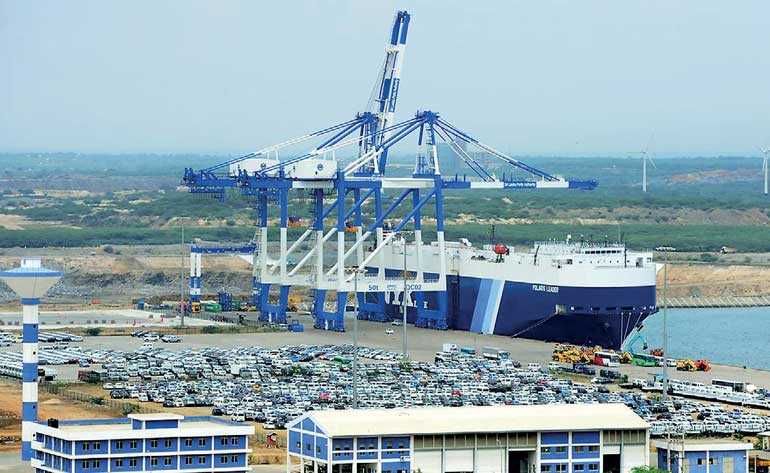Sunday Dec 14, 2025
Sunday Dec 14, 2025
Tuesday, 16 October 2018 00:00 - - {{hitsCtrl.values.hits}}

Sri Lanka needs to renegotiate the Hambantota Port deal to make it more advantageous for Sri Lanka. This action alone would go well with the US authorities (and India)
When no less than the Vice President of USA publicly announces their concern over China’s increasing presence in Sri Lanka, it would be imprudent for us not to take notice. When he also states that USA is actively looking at providing an alternative, there is no time to waste for our policymakers. This could be the window of opportunity of a lifetime. Under President Trump’s “new thinking”, it could be a decisive moment in its history for Sri Lanka. If only the policy makers get the foreign policy and economic policy right.
The story of the Asian Tiger economies
It is well known that the miracle economic growth of the four Asian tigers – South Korea, Taiwan, Hong Kong and Singapore – was driven by the support of the USA. The anti-communist geopolitics at play in 1960s prompted the USA to provide “favoured nation” status to these countries who devotedly took the side of the USA against Communism. The “favoured nation” status allowed these countries to penetrate the lucrative USA market and successfully execute the “export oriented development” strategy.
Therefore, irrespective of the prudent economic policies implemented by these countries, a crucial factor for their rapid development was their astute foreign policy. They aligned with the right side at the right time in history. In 1960s it would have been almost impossible for someone to have predicted the demise of the communist Soviet Union in the 1980s, which would underline the risk undertaken by these countries at that time to side with USA.
History repeating again?
It is seemingly a case of history repeating itself (in a different form) right now as China increases its presence globally. The equation was possibly more simpler three years ago when China was racing ahead. The foregone conclusion was China would overtake USA in the coming decades.
However the equation is a bit more complicated right now, since the new US policy came into effect two years ago. Going by the statistics of economic growth and stock market performance, it is the USA that is at the better end of the trade war so far while China is being pulled back. The USA has signalled that it is going to compete actively with China to retain its global economic leadership. They are in need of new economic frontiers and bases.
Sri Lanka’s enviable asset
It is Sri Lanka’s fortune that it sits in a strategic location. It is at a crucial point in China’s Belt and Road initiative and for that reason alone Sri Lanka would be of strategic importance for USA as well. Coupled with the recent comments of the Vice President of USA, it is time for the policy makers to strategise how to exploit this priceless asset in the form of adjusting the foreign policy, to attain long term economic goals.
This is not necessarily to say that we should side with one and against the other. That could be an option as well. Another option could be to utilise both these powers wisely.
What should be the economic goal?
Clearly we need to understand what the long-term economic goal should be. Arguably it would be to increase the footprint in the global economy by penetrating the global supply chains or in simple terms to sell more high end products and services to the world (while buying comparatively less from the rest of the world). This would boost foreign currency earnings, increase foreign reserves, stabilise currency, provide high end employment (possibly reverse brain drain), and increase per capita income.
This is where one should realise the importance of USA, which is the most common end destination of the global supply chains and the largest importer of the world. It is USA that provided the market for countries such as Japan and the four Asian tigers to develop. China would not be the current economic powerhouse, if not for the US consumers who kept on buying the Chinese goods for decades.
Foreign Trade Policy – root of economic woes
In the above context, it is crucial for Sri Lanka to realise its current role in the global supply chains. The simple table below shows the hard facts. As a single country, it is the USA who has been our most loyal client providing us a trade surplus of over $ 2 b p.a. On the other hand, the trade deficits for Sri Lanka with both India and China are close to a whopping $ 4 b p.a.
It is worthwhile to note the sentiments of Donald Trump on China – “China has been selling their goods to us while paying very low taxes and they have given the same money back to us in the form of loans making us indebted to China”. While it could be an exaggeration, the underlying logic cannot be ignored. In fact, this sentiment may apply even more so for Sri Lanka.
We buy Chinese goods worth almost $ 4 b p.a., and a minority of the same money is lent to us by China.
And in the case of the Hambantota port, China acquired the ownership of a most strategic asset, using less than half of the money we give them annually!
Understanding the concerns of USA
Here lie the concerns of USA as voiced by the Vice President himself. It is most likely that the US feels that we are getting into a trap set by Chinese without our knowledge or due to our incompetence in managing the economy. Going by the above statistics and the actual turn of events, one couldn’t find fault with the USA for coming into such a conclusion.
The time could be running out for Sri Lanka. USA may use the “human rights violations” excuse to step into Sri Lanka forcefully to neutralise the Chinese threat. Therefore, it would be time for policy makers to get the foreign, trade and economic policies right without further delay.
Negotiate strategically with China and India
Firstly, Sri Lanka would need to renegotiate the Hambantota Port deal to make it more advantageous for Sri Lanka. This action alone would go well with the US authorities (and India). Secondly following Trump’s strategy, Sri Lanka should directly take up the trade deficit issue with both China and India. The negotiations should be around increasing Indian and Chinese investments in Sri Lanka so that Sri Lanka enters the global supply chains of both India and China.
In simpler terms, Sri Lanka should become a production base of the goods and services produced by China and India to the rest of the world. If not, the tariffs would need to be raised gradually and substantially to curtail the import bill from these countries. The increased tax revenue from these measures could be utilised by the Government to develop the same industries locally.
Strong case for trade concessions from USA
One could argue that by negotiating strongly with China (or allaying US’s fears of Sri Lanka becoming a pawn of China), a strong case could be made for Sri Lanka to approach USA to open up its market for Sri Lankan goods and services (or make Sri Lanka a “favoured nation”). Sri Lanka should aim to ink a trade deal with USA to penetrate the largest and the most sophisticated global market. The objective should be to increase the export value to USA by multiple times from the current level of $ 2 b p.a.
The required technology could be acquired from China and India in the form of investments as suggested earlier. The Government would also have to direct fiscal policy to support this strategy. Provide tax concessions for the relevant industries and direct capital expenditure to develop the required capacity – labour, technology, etc. As new industries emerge, a much needed reverse brain drain could be triggered as employment opportunities open up for skilled Sri Lankans who have migrated.
This would be a similar strategy to that was adopted by South Korea five decades ago at the early stage of their development, as they acquired technology from Japan and penetrated the US market.
Sri Lanka should dare to dream big
The above strategy of negotiating forcefully with regional giants may sound impractical for some. However the current strategy (or no strategy) of being the “nice person” in negotiations and accepting whatever that is dished to us has not got us anywhere. In fact, it has probably escalated concerns in the developed world (USA, IMF) that we are poor economic managers.
As the term comes to an end for the current Government, the work is cut out for the next Government that would come to power in a year or so.
With the US economy rebounding sharply, there’s no reason to think that President Trump wouldn’t win a second term.
Therefore, the next Government may have a five-year window to set the base to utilise India and China and penetrate USA, to send the Sri Lankan economy on a miracle growth ride in the coming decades.
(The writers could be contacted via [email protected])